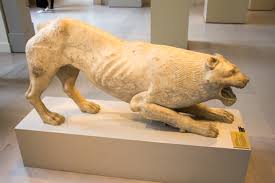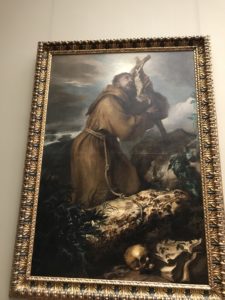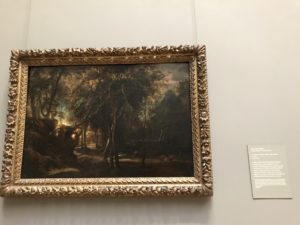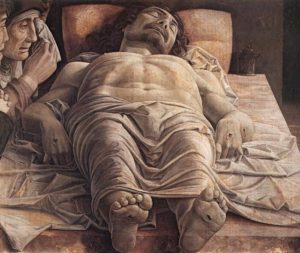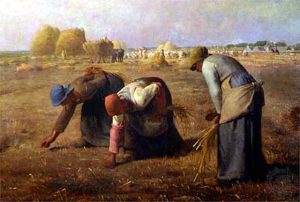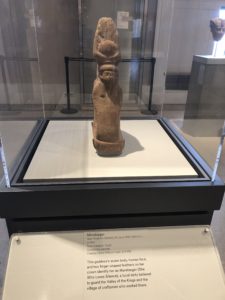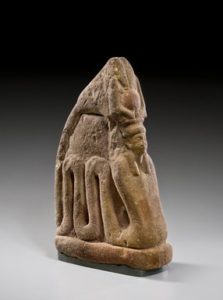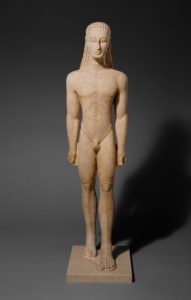Good morning Ladies & Gentleman, I am Naomi and I will be your tour guide for today. If you are apart of this tour today it is because you have taken a special interest in emotions depicted in different forms of art. Throughout history, forms of art have successfully represented emotions and stories in different ways. We see emotions and stories further deepened in details like body language, facial expressions and symbolism. The MET is filled with so much history and beauty. I hope you all enjoy and appreciate the pieces I have selected for you. This tour will be about thirty to forty-five minutes long with an included bathroom break. The MET is a huge building, and it can also be crowded, be sure to stay close to not miss a thing. If you have any questions, feel free to ask.
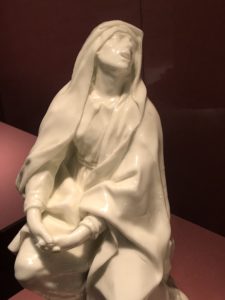
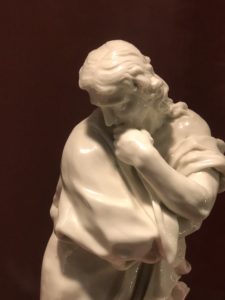
For our first artwork, I want to introduce you to Giuseppe Gricci‘s, The Mourning Virgin and Saint John The Evangelist. This beauty is made of soft-paste porcelain and was made in Naples, Italy in 1744. They’re very small so I want you all to get close to closely see it. As you can tell from the name of this piece, this depicts the Virgin Mary after the death of her son, Christ, and Saint John right next to her. The way Giuseppe portrayed them in their mourning is just impressive and it’s almost like the material that they were made out of captures the mourning even better. We should first focus on the Virgin Mary’s face. Her head is tilted up with her mouth open and her eyes. Then, we also see her body language, she is then propped up on one knee as if her grief has taken over her. When we look over at Saint John, his body is turned away from the Virgin but his head is facing her. Almost as if he is in shock at what had happened and also feels shame. The drapery that is shown almost makes it look like as if they are in movement. The white porcelain makes them look so fragile from their grief. From the emotion on their face to the material that they are done out of, Giuseppe successfully shows the aftermath of Christ’s death that is filled with horror and sorrow from the ones who followed him. In this case, Giuseppe used his material to emphasize the pain St. John and the Virgin Mary felt. This is a perfect first demonstration of emotion and the emotion of a story being shown in art. The sadness is already apparent before you even know any context behind it, and that ladies and gentlemen is very powerful in itself.


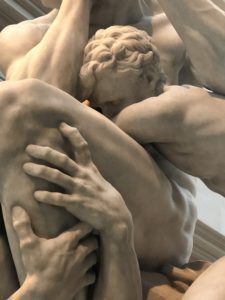
This next masterpiece, is called “Ugolino and His Sons” created by Jean-Baptiste Carpeaux. It is made of Saint-beat Marble and was made in 1865-67, Paris. The name of this artwork is not as revealing as the first work of art that we looked at, so I want you analyze this statue deeply and try your best to look at every single detail. It is very obvious that the man in the front, Ugolino, is in extreme anguish. You can see his knotted body and the way he has his fingers in his mouth. On top of his anguish, it’s almost as if he is indecisive about something. If you focus on the kids around him, his sons, they all are around him either laying on him, hiding in his body, or clinging to him. We see three of them either asleep or maybe even dead and the one who seems to be the older one is the only one looking up at him in some sort of desperation. We see that they are suffering and it comes across very loud and clear. The story behind this statue comes from the epic poem, Dante’s Inferno.Dante encounters Ugolino and his sons locked in a tower after Count Ugolino betrayed his city, Pisa, by giving away fortresses to other towns. When locked away, his sons were complaining about being hungry. When mealtime came, he noticed the door was being nailed. That is when he realized that he would starve in that tower with his sons and other sinners. Driven insane from starvation and seeing his sons slowly die, Count Ugolino was faced with no other choice but to become a cannibal. In some stories, it is said he ate the bodies of his sons and in others it is said he continued to starve. I chose this to be apart of the tour because it is a piece of art that only intensifies the emotions you feel after you hear the story. You experience their emotions before knowing anything about it and pick up on their horror. You notice their facial expressions and their body language but do not know why. Once you find out, you can’t help but feel even more horrified. Carpeaux is just another artist that has managed to envelop you before and after you hear about his inspiration.


The last statue we will be looking at today is called “The Martyr.“This bronze piece was made by Auguste Rodin in 1898, France. This is another work of art that’s name really gives away the story behind it. However, I want you all to look at her body language and forget about her facial expression. Her body language really gives away her suffering. Whenever we see an artwork of death, we typically see them lied down flat, but here we have something different. We see her arms spread wide, her legs are at a weird angle, and her is almost hanging off the altar she is put on. We can safely conclude that she suffered a great deal of pain before her death. A martyr is someone who is killed for their religious believes and the deaths of the Apostles serve as a testimony that these deaths are very morbid and gruesome. Rodins, “The Martyr” shows that she comes a “symbolic martyr to humanity‘s shard fate. Her youth evokes death‘s universality, her nakedness its indifference, and her isolation the loneliness of the final struggle.“This artwork can compare to Carpeaux‘s “Ugolino and his Sons” because of the decision to express emotion through body language. We hear her tragic ending being told by the way she is positioned on this alter. Although her face does give off a lot of emotion, her body is the statement. The title of this work, her body language, and her bodies symbolism all come into one to tell her tragic tale.

This painting is called “The Penitent Magdalen.” This oil on canvas was made by George de La Tour in 1593-1633, France. Mary Magdalene is known for being the personification of christian fidelity. It is said that Mary Magdalene was a Jewish women who followed Jesus to the death. When Jesus was set to die on the cross and his men abandoned him, Magdalene stayed by his side. She is said to be around him at his tomb and to be the first to announce his resurrection. As you can see, this is the first work of art that does not show a face. Her head is turned away, and we are left to only work with her body and the objects around her. We see a skull on her lap, her hands crossed, a mirror and a candlelight. It is said that Mary Magdalen “renounced the pleasures of the flesh for a life of penance and contemplation.“The mirror is a symbol of”vanity“, the skull on her lap is an “emblem of mortality“, and the candle light most likely stands for her “spiritual enlightenment.” If we moved on to focus on the colors of this painting, the only thing that is lighted from the candle light is the top of her robe. The rest of the painting is filled with shadows and dark colors. We look at this painting and keeping all in the information in mind, we pick up that this an hour of solemnity. This is contrasts from all the statue work we have seen today, but still falls in line, because although we don’t see a face, we are still giving enough objects to grasp the emotion of this painting. Her hands, the skull, the mirror, and the candlelight are enough to give us what we need to understand the sentiment of this painting.

For the last artwork of this tour, This painting is called “The Rape of Tamar.“This oil on canvas was made by Eusatche Le Seur in 1614. This graphic scene tells the story of Tamar being raped by her half-brother Amnon. In the bible, II Samuel 13:1-22, Amnon was a son of David and fell inlove with Tamar. He convinced his friend to help set up a plan which consisted of Amnon faking a sickness and ordering that Tamar attend to him. When they were alone, he turned on her and raped her. After realizing what he had done, he sent her out of his chamber.When Tamar‘s brother, Absalom, realized what had happened, he had Amnon killed. Of course, the face of Tamar and Amnon really gives away the horror and chaos of the scene, but I want you to focus on what is going on in the rest of the painting. From behind them, we see a figure walking away, which we can guess is the friend. He could depict the betrayal that happened here. On the floor, we see objects fallen over. Notice also the movement that is in this picture. The robes of the man in the back are behind him. The white drape of Amnon is also all behind him, only covering his privates, the top of Tamar‘s dress has the same type of movement. Her hair is also in mid-air. Le Seur literally paints this scene in mid-moment right before the rape happens. By doing this, Le Seur accurately shows the chaos of this scene, and he does it in more than one way. He uses all of his canvas to his advantage to set this violent act in motion. The little things do matter in this painting. In taking in all of these things, we feel for Tamar because of the betrayal and the impulsiveness that comes from Amnon. With a painting like this, knowing the story is only the beginning in experiencing the horror of this act.
Well ladies and gentleman, I really hoped you all enjoyed this short tour. It has been a pleasure taking you around the MET and showing you some of my favorites statues and paintings. I hope you were enammored by the different stories and emotions shown just as I was when I first learned of them. Feel free to roam around the rest of the museum and see what other stories you may find. Have a great day and enjoy the rest of your stay.


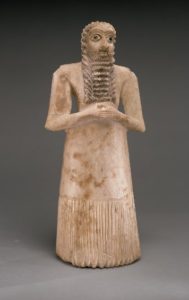 Artist: N/A
Title: Standing Male Worshiper
Date: 2900–2600 B.C.
Museum: The Metropolitan Museum of Art
As time began to progress so the idea of humanism began to form and the shift from making art that focused on deities and worshiping them to making art that worshiped humanity and focused on the ideal human body. An example of an artwork that showed the start of the transition from focus on deities to a focus on humans is the Statue of Kouros. Unlike the Standing Male Worshiper which had almost no detail on the human body, the Statue of Kouros focuses soley on the human body. It is a representation of a young nude male. The artist of this sculpture adds small but noticeable details such as the outlining of the mans abs and chest. Another faint but drastic difference between the two sculptures is the sense of movement that can be seen in the legs of the Statue of Kouros. As seen in the photograph below, the left leg of the statue strides forward giving the sculpture a feeling of movement.
Artist: N/A
Title: Standing Male Worshiper
Date: 2900–2600 B.C.
Museum: The Metropolitan Museum of Art
As time began to progress so the idea of humanism began to form and the shift from making art that focused on deities and worshiping them to making art that worshiped humanity and focused on the ideal human body. An example of an artwork that showed the start of the transition from focus on deities to a focus on humans is the Statue of Kouros. Unlike the Standing Male Worshiper which had almost no detail on the human body, the Statue of Kouros focuses soley on the human body. It is a representation of a young nude male. The artist of this sculpture adds small but noticeable details such as the outlining of the mans abs and chest. Another faint but drastic difference between the two sculptures is the sense of movement that can be seen in the legs of the Statue of Kouros. As seen in the photograph below, the left leg of the statue strides forward giving the sculpture a feeling of movement.
 .
Artist: N/A
Title: Statue of Kouros
Date: 600 BCE
Museum: The Metropolitan Museum of Art
As more time passed the humanism movement became larger and lead to much more drastic changes in the art world. An example of a artwork that shows drastic a drastic change due to the humanism movement is the statue of Polykleitos. Similar to the statue of Kouros, the Doryphoros has a sense of movement but different to the Kouros, the Doryphoros has no symmetry. Instead the statue of Polykleitos has contrapposto. Contrapposto is the use of counter balancing to form "an asymmetrical arrangement of the human figure in which the line of the arms and shoulders contrasts with while balancing those of the hips and leg."(Google definition).By giving the statue contrapposto it the artist was able to show that the statue is suppose to represent a person walking.
.
Artist: N/A
Title: Statue of Kouros
Date: 600 BCE
Museum: The Metropolitan Museum of Art
As more time passed the humanism movement became larger and lead to much more drastic changes in the art world. An example of a artwork that shows drastic a drastic change due to the humanism movement is the statue of Polykleitos. Similar to the statue of Kouros, the Doryphoros has a sense of movement but different to the Kouros, the Doryphoros has no symmetry. Instead the statue of Polykleitos has contrapposto. Contrapposto is the use of counter balancing to form "an asymmetrical arrangement of the human figure in which the line of the arms and shoulders contrasts with while balancing those of the hips and leg."(Google definition).By giving the statue contrapposto it the artist was able to show that the statue is suppose to represent a person walking.
 Artist: Polykleitos
Title: Doryphoros (Roman copy)
Date: 450-440 BCE
Museum: Museo Archaeologico Nazionale (Naples)
Artist: Polykleitos
Title: Doryphoros (Roman copy)
Date: 450-440 BCE
Museum: Museo Archaeologico Nazionale (Naples)

